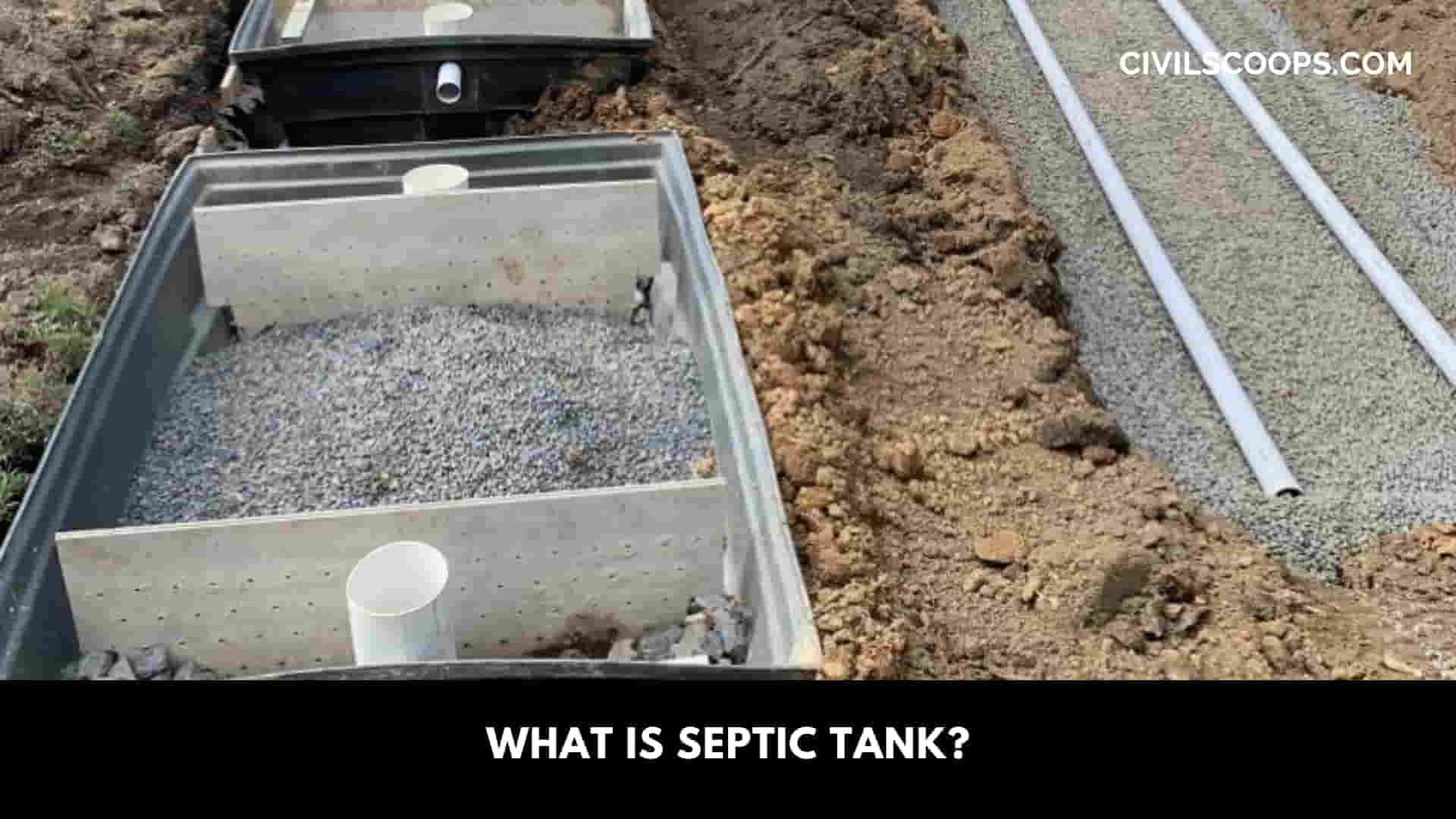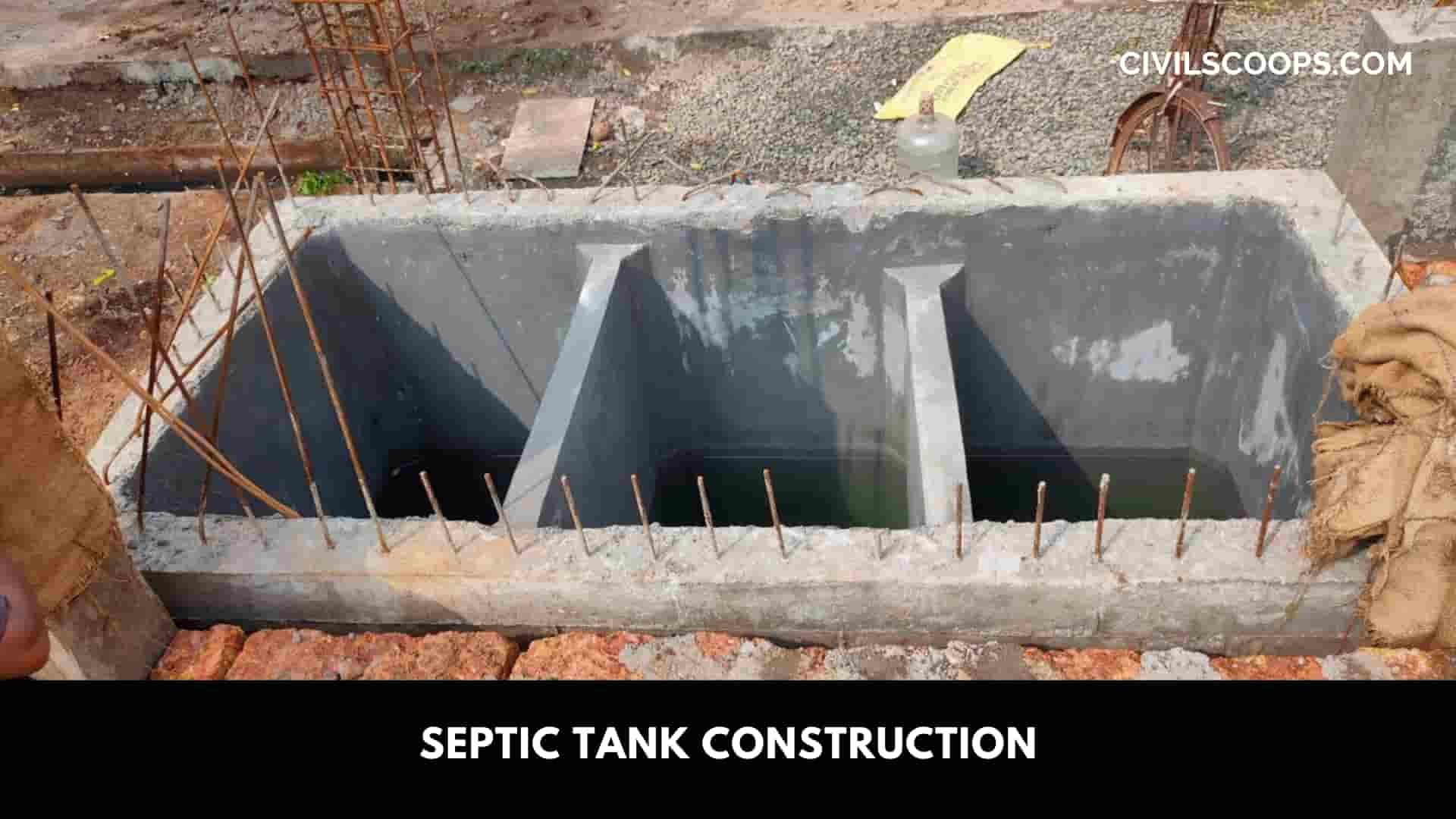What Is Septic Tank | How Does A Septic Tank Work | Septic Tank Design based Per User Consumption

Table of Contents
What Is Septic Tank?

A septic tank collects and treats wastewater in a property that isn’t linked to the mains sewer system and is, thus, most commonly used in rural areas.
The term ‘septic’ means’infected with microorganisms’; the tanks contain bacteria that break down organic waste.
The inclusion of a bacterial treatment mechanism would be the difference between a septic tank and a cesspit, and such structures have both industrial and residential appliances.
Installed underground, a septic tank makes use of natural processes to treat the sewage it stores. Usually made up of two compartments or chambers, the tank receives wastewater from an inlet pipe.
If you’re in need of maintenance servicing or work on a Septic Tank, follow this link, otherwise read on to learn more about Septic Tanks, and how they may be emptied.
How Does A Septic Tank Work?

A septic tank May digest organic matter and separate float-able matter(e.g., oils and grease) and solids in the wastewater A septic tank will be connected with two pipes (for inlet and outlet).
The inlet pipe can be used to transport the water waste from the house and collect it in the septic tank. It’s kept here long enough so that the liquid and solid waste are separated from each other.
The second pipe is the outlet pipe. It can also call the drain field. This pipe moves out of the pre-processed wastewater from the septic tank and spreads it evenly from the soil and watercourses.
When waste-water was collected after a while, it will begin to separate into 3 layers. (as shown in the image above) The top layer is oils and grease and floats above all the waste.
This commonly referred to as”scum.” The middle layer contains wastewater along with waste particles. The third and bottom layer consists of particles that are heavier than water and form a layer of sludge.
Bacteria within the tank does it is best to break down the solid waste, which then allows liquids to drain and separate away easily.
What’s left at the bottom of the tank is what needs to be periodically removed as part of general maintenance. This is one of these reasons why a septic tank is only a basic form of sewage treatment.
Septic Tank Construction

It’s best to construct a single compartment for small capacity septic tanks. Larger capacities are the best fit for a both-compartment tank.
The wall separating the both is about two-thirds the length away from the inlet. It, therefore, perform better than the single compartment tank.
Both compartments interconnect above the sludge storage using pipes or square openings. A plastic or concrete tank would be the best to use.
The floor and side walls are made with plastered and concrete to render a smooth surface. The floor has a slight slope of 10 percent towards the sludge outlet.
As a result, slung moves out more easily. The top cover of a septic tank is watertight and very thick. But a manhole of relative size is created. This allows inspection and emptying of the tanks.
Septic Tank Design Based Per User Consumption
The proper capacity of a septic tank is essential otherwise wastewater backflow toward the house. The septic tank system much designed considering a future increase in wastewater generation design proper capacity septic tank that may last long for years.
Let take one example of House – 4 Members.
Daily Water Usage for a House – 4 Person
Cooking – 8 Liters
Bathing & Toilet – 90 Liters/Person, So for 4 person – 360 liters/Day
Washing clothes & Utensils – 28 Liters
Cleaning House – 12 Liters
Other – 8 Litres
Total – 416 Litres/Day Approximately
We consider detention time as 4 days. So the designed tank should have the capacity to retain the household wastewater at least 4 days.
Total wastewater in 4 days – 416 × 4 = 1664 Liters
So, we take more than that about 1800 Liters capacity minimum for a home. For Septic tank design depth of the tank should not be less than 1.5m.
Take sludge settled down per person – 30 liters/year. So here we take sludge removal 1 year once.
Total Accumulated Sludge = 30 litres x 4 persons x 1 years = 120 Litres
Total Septic Tank Capacity = 1800+120 = 2120 Liters
We know that 1 cubic meter = 1000 Liters = 2120 /1000 = 1.92 Cum
Area required @ 1.8m depth = 1.92 / 1.5 = 1.28 Sqm
We take the Length and Width ratio of Septic Tank is 4:1 or 2:1
Length(L): Breath(B) ratio taken as 4 : 1
So, 4 B2 = 1.28 Sq. m where B=0.565 m
(Note: Minimum width of tank should not be less than 750mm)
So that L = 4 × 0.75 = 3m
L – 3 m; B – 0.75 m ;
Depth = 1.5 + 0.3 = 1.8 m (free board should be provided at least 300mm)
Septic Tank capacity = 3 x 1.8 x 0.75 = 4.05 Cum
Septic Tank capacity = 4.05x 1000
Septic Tank capacity = 4050 Liters
British Standard Calculation:
British standard given following formula calculate the wastewater flow for a septic tank.
C=A + P (r q + n s)
Where,
C = Capacity in liters
P = Number of People
A = 2000 Litres as constant
R = Detention period of Sewage in Days
Q = Sewage Flow in liter per day
N = Number of years
S = Sludge accumulation in liters per person/year
Simplification of (r q + n s) = 180 Litres
We can Rewrite this formula C=A + 180 P
C = 1800 + (180 × 4)
C = 2520 Litres
[su_box title=”FAQ” style=”default” box_color=”#333333″ title_color=”#FFFFFF” radius=”3″ class=”” id=””]
What to Do After Septic Tank Is Pumped?
Use water efficiently, and don’t flush or pour anything down the drain that doesn’t belong. There’s no need to use septic tank additives or do anything special after getting your tank pumped. Just use your household water systems like normal.
What Can You Put on Top of a Septic Field?
Put plastic sheets, bark, gravel or other fill over the drainfield. Reshape or fill the ground surface over the drainfield and reserve area. However, just adding topsoil is generally OK if it isn’t more than a couple of inches.
Why Is My Septic Tank Full of Water?
If your pipes or septic tank have cracks, wastewater can seep out of your septic tank, but other groundwater can also get into your tank, causing it to fill up quickly. Damage can also occur if someone drives over your septic tank, causing cracking or breaking in the tank. Heavy rainfall and standing water.
What Is a Septic Tank Used For?
The septic tank is a buried, water-tight container usually made of concrete, fiberglass, or polyethylene. Its job is to hold the wastewater long enough to allow solids to settle down to the bottom forming sludge, while the oil and grease floats to the top as scum.
What Does a Septic System Cost?
If you are considering putting in a septic system, the cost ranges from $3,600 to $10,000 with an average cost for septic tank installation is $6,300. Although less common for average homeowners, specialized systems on the high end may cost upwards of $20,000.
When a Septic System Fails When Buying a House?
It’s important to know that you can still purchase a house with a failed septic inspection. Oftentimes this is presumed when someone lists a property for sale “as is”. However, purchasing a home with a bad septic system can be high risk and the necessary precautions should be taken before doing so.
Which Is Better Plastic or Concrete Septic Tank?
Concrete septic tanks are superior to fiberglass or plastic because they are watertight and heavy duty, making it the ideal preferred storage vessel for on-site septic storage and treatment. In the United States, there are 40 million septic systems in service.
When Should You Empty Your Septic Tank?
For a typical household, septic tanks are usually pumped every three to five years. Routine pumping can prevent expensive failures such as a clogged drainfield or sewage backing up into the home. Using a garbage disposal will increase the amount of solids entering the septic tank, requiring more frequent pumping.
Why Does My Septic Tank Smell When It Rains?
When it rains, the air becomes heavy and doesn’t allow for proper release of methane gases through your vent. As a result, the gases stay low to the ground with the atmospheric pressure, which results in a foul smell.
What Is the Purpose of a Septic Tank?
Your septic tank is the first step in the process of sewage conditioning, in a subsurface disposal system. Without it the untreated sewage would quickly clog the receiving soil and prevent the purification process of leaching and soil percolation.
How Much Is a New Septic System?
The national average cost for a septic tank installation is $7,015, according to home improvement information site and network HomeAdvisor. Installation of a complete septic system can cost $10,000 to $25,000. Septic tank installation requires initial ground tests to ensure the soil is suitable to hold a septic tank.
Why Does My Septic Smell Outside?
It’s normal to occasionally notice a weak smell near the septic tank, but a strong odor could be a sign of a leak from the manhole. Check the risers and manholes to make sure they’re covered securely.
How Big Is a Septic Tank?
A typical residential septic tank is usually around 4.5 feet wide x 8.0 feet long x 6 feet tall, though this is just a jumping-off point, as many tanks exceed this size. The average tank clocks in at 30 to 40 square feet.
How Deep Is a Septic Tank?
Septic tanks are typically rectangular in shape and measure approximately 5 feet by 8 feet. In most cases, septic tank components including the lid, are buried between 4 inches and 4 feet underground. You can use a metal probe to locate its edges and mark the perimeter.
How Much Is It to Pump a Septic Tank?
The average cost to pump a septic tank is about $400, though the price can range between $225–$600 for most residential tanks.
Where Is the Septic Tank Located?
Your septic tank will most certainly be installed along the main sewer line that runs out of your home. Look for the 4-inch sewer that exits the crawl space or basement, and locate the same spot outside the home. Septic tanks are usually located between ten to 25 feet away from the home.
How Much Is It to Empty a Septic Tank?
The average cost to pump a septic tank ranges between $225–$600. Regular inspections keep things running smoothly, typically costing between $150 – $450. Depending on type of repairs, you can expect to pay $200 – $6,000.
How Does a Septic Tank Work?
Sewage from all plumbing fixtures drains into the septic tank, where heavy solids settle to the bottom, where bacterial action produces digested sludge and gases. The lighter solids, such as grease, oils and fats, rise to the top to form a scum layer. Solids that are not decomposed remain in the septic tank.
How Does a Septic Pump Work?
In normal operation, effluent from the septic tank fills the pump chamber and the pump controls keep the effluent between the two lower floats. These floats are typically set to discharge a volume of effluent somewhere between the daily flow from the house and one-quarter of the daily flow.
How Do Septic Tanks Work in Rural Areas?
Wastewater flows from your home, by gravity, into the first chamber of the septic tank. Solids settle to the bottom forming a sludge, oils and grease float to the top forming a scum and microbes slowly break down the waste.
Can You Have a Septic Tank Without a Leach Field?
Sand Filter
This is one example of an alternative septic system without a leach field, which makes it compatible with environmentally sensitive areas. In some cases, the treated water can pass directly from the sand filtration system to the soil without needing to flow through more piping to a leach field.
Do All Houses Have Septic Tanks?
Septic tanks are crucial to the removal of waste from establishments. Only an estimated 20% of houses have septic systems, with sewer systems being a more common option for disposing of wastewater in the city.
When to Pump Septic Tank?
Septic tanks usually need to be pumped every 3 to 5 years, depending on the amount of water use. Generally, septic tanks fill faster as more people use the septic system. This means more frequent pumping will be needed with larger households.
[/su_box]
[su_note note_color=”#F2F2F2 ” text_color=”#333333″ radius=”3″ class=”” id=””]
Like this post? Share it with your friends!
Suggested Read –
- What Is Window Glazing | Types of Window Glazing
- What Is Linear Measurement Surveying | Types of Linear Measurement Surveying
- What Is Folded Plate | Folded Plate Structure | Folded Plate Roof Construction Details | Folded Plate Staircase | What Are Folded Plate Roofs
- All About Brick Bat Coba | What Is a Brick Bat Coba | Procedure of Brick Bat Coba Waterproofing | Advantages & Disadvantage of Brick Bat Coba Waterproofing
- What Is Shotcrete | Shotcrete & Concrete | Shotcrete Technology | Types of Shotcrete Technology | Advantages of Shotcrete | Disadvantages of Shotcrete
[/su_note]
Originally posted 2023-03-27 11:54:15.
